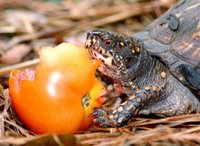Friday, August 31, 2007
Monday, August 27, 2007
Rain!
About five o’clock this afternoon a beautiful small thunderstorm passed through, leaving much-needed rain. It started to fall in big fat drops that soon became a steady downpour, and I stood and watched it for a long time, soaking up the sound and smell of the rain and the cooling feel of damp air. It rained for about 45 minutes, I think, not nearly enough to make up for the long hot, dry spell that has lasted most of August, but enough to provide some relief and a good soaking for our parched trees and landscape. And it looks likely that more rain will come in the next few days, so maybe the heat wave has finally broken.
August is almost always hot in Georgia, but this year, beginning August 5 and continuing for almost three weeks, we’ve had one of the worst heat waves I can remember. Every day temperatures reached near 100 or above, with only one brief, fierce thunderstorm on August 9, which blew down a lot of branches, leaves and pine needles, and the top half of a large dead pine that fell right in the middle of the rough clearing that passes for our back yard.
I've tried to keep out fresh water in the bird baths during this time. The creeks aren't far away, and there are plenty of trees and shrubs for cover. But I've still wondered what effect this extended hot, dry period has had on our birds, especially the songbirds, and whether some might have more trouble than others surviving the unusual heat. They're always quiet at this time of year, so it's hard to tell.
Friday, August 24, 2007
Young Red-shouldered Hawk
Early one morning about a week ago, a juvenile Red-shouldered Hawk flew low across a grassy lawn and perched in a tree near the side of the road where I was walking. As I grew closer, it flew out of the tree to the middle of the road right in front of me, only a very few yards away, where it captured something that looked like a large insect, maybe a cicada. The hawk looked up at me briefly, then calmly turned back to its prey, holding it with its feet and beginning to pull it apart with its beak. The hawk’s legs and feet were yellow, the streaks on its breast dark brown, and the rest of its coloring all over a muted, streaky brown and white – unlike the rich reddish breast and shoulders, and black and white striped tail of a mature Red-shouldered Hawk.
I stood still and watched until I heard a car approaching from the opposite direction and knew that the driver wouldn’t see the hawk until too late because it was coming up a hill. So I reluctantly clapped my hands and stomped at the hawk – which looked up at me, still not leaving, until I ran at it and yelled and clapped louder. Finally it flew, holding its prey in its feet, barely in time to get out of the path of the car, which fortunately was not going as fast as some do.
This morning about 8:15, I saw the young Red-shouldered Hawk again in the same general area when it flew suddenly onto the road just ahead of me, no more than 10 yards away. This time it picked up what looked like a cicada and flew with it to a low perch on one of several large pecan trees in a grassy, shady yard. With the pond and a creek nearby for water, the trees full of insects, and the grass around the pond probably home to rabbits, small rodents and frogs, the young hawk seems to have found a territory to its liking, at least temporarily.
Red-shouldered Hawks are forest-loving birds whose habitat is shrinking as development replaces wooded land. Cutting large areas of forest, or breaking a forest up into fragmented pieces already has made them less common in many areas, and it seems likely that as their habitat shrinks we could see them less often in this part of Georgia. We’ve had a resident pair around our neighborhood for the past several years and often see them soaring, hear their cries, or see one flying through the trees. I feel lucky to have them around and glad that we still have enough woods and mature trees to provide habitat for them.
Wednesday, August 22, 2007
A Parula Warbler’s Cool Song, and a Sun-loving Blue Grosbeak Pair
For the most part, birds have been very quiet lately, but early this morning, despite the continuing heat wave – with temperatures of 100+ expected again today – a surprising number of birds were active. Near the pond, a Parula Warbler sang its buzzy, rising song, sounding like cool water and shady trees.
Four Bluebirds perched together in the top bare limbs of a small tree at the edge of a yard. A Red-eyed Vireo sang from the treetops near our house – the first one I’ve heard singing for some time now. Blue-gray Gnatcatchers called spee! from bushes along the roadside. A Great-crested Flycatcher called whreep! Chimney Swifts chittered as they swept overhead. The calls of Carolina Wren, Goldfinch, Mourning Dove, Red-bellied Woodpecker, Downy Woodpecker, Cardinal, and Blue Jay came from yards and bushes all through the neighborhood.
In the dry, drooping thickets of the Old Field, a White-eyed Vireo and an Eastern Towhee sang, and a Catbird complained in a hoarse mew. A Red-tailed Hawk perched on the top of a pole overlooking Highway 441, and a Turkey Vulture floated in a bleached-blue sky. Mockingbirds sat quietly perched on wires or flew down to the grass to hunt.
But the real sun-worshippers among the birds seem to be the pair of Blue Grosbeaks that have made their summer home in the Old Field. Every morning for the past week or more, the male has been perched on a wire over the edge of the field singing, and every morning the female flits from stem to stem in the tall grassy weeds below the wire, flashing her tail and calling a metallic plink! The male usually looks like no more than a dark silhouette on the wire, but when the morning light hits him, his deep blue plumage with orange wing bars shows up richly. The female’s tawny colors also are easy to miss, but she’s very active and vocal as she moves around in the weeds – and their distinctive, almost bell-like calls usually get my attention even when I’m not looking for them.
Two male Blue Grosbeaks have been singing in different areas of the Old Field all summer, usually making fairly predictable circuits of their territories, singing in different spots at different times. It’s only recently that this male and female have been so consistently staying right around this one spot just on the edge of the field. This morning, I also saw a third Grosbeak in the weeds with the female, and I’m guessing it’s a juvenile.
Tuesday, August 21, 2007
Raccoon with a Sweet Tooth?
Every morning for the past week or two the hummingbird feeder that hangs off our back deck has been pulled toward the deck rail and emptied of most of the nectar. We’ve never caught the culprit in action, but think it’s probably the same fat raccoon we’ve seen occasionally crossing our back yard at twilight. Yesterday morning, some large red ants also had discovered the feeder, and I think they were able to get in once the water moat in the middle had been emptied. Dozens of them were clustered inside the top and on the sides. I rinsed them all out, refilled the feeder, and tried once more, but when I found the same thing again this morning, I took down the feeder and moved it to a different spot, this time in the front yard.
Three Ruby-throated Hummingbirds hummed and hovered around the deck off and on all morning, but I hope they’ll find the new spot soon.
Monday, August 13, 2007
Another Hot day . . . Red Admiral, Blue Grosbeaks and Red-eyed Vireos
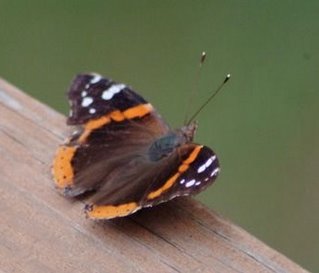
A Red Admiral butterfly continues to visit the butterfly bush beside our back deck, along with the Tiger Swallowtails and Silver-spotted Skippers that are almost always there. The Red Admiral is dwarfed by the big, floating, flamboyant Tiger Swallowtails, and it moves differently, fluttering swiftly in, almost furtive, settling in one spot for several seconds with wings outspread, lying low, somehow inconspicuous despite its brilliant coloring, then suddenly fluttering off again, as if frightened away.
It looks like we’re in for another week of 100-plus degree weather, with no rain in sight. I’ve begun to worry about our trees, especially the two young red maples and three river birches that we planted in the front yard five years ago. They’ve grown strong, tall and healthy, and every day it makes me smile just to see them; the maples sturdy and thick with full shapes of deep green leaves; the river birches graceful and slender, with pale, peeling bark and small leaves that shimmer in the slightest breeze. I’ll do what I can, starting this evening to water them with a dripping hose on the two days a week when outdoor watering is still allowed. They’re well mulched, and should be strong enough to take a lot of stress, but this prolonged period of heat and no rain is harsh, and the effects are beginning to become apparent in many trees and other vegetation. One small water oak at the edge of our woods has turned brown in the past few days.
Despite the hot, dry weather, birds seemed more active early this morning than they have been for a while. Two Red-eyed Vireos sang from the edge of the woods, sounding especially sweet and clear in the soft, early light. As I walked through the neighborhood, I also heard a Black and White Warbler, Blue-gray Gnatcatchers, a White-eyed Vireo, lots of Bluebirds, Titmice and Chickadees, a Downy Woodpecker, Red-bellied Woodpecker, Carolina Wrens, and the Tow-heee calls of Eastern Towhees, not to mention the usual complaints of Blue Jays and Crows. Two Phoebes hunted quietly from low branches, Goldfinches called potato-chip as they passed overhead, and a Ruby-throated Hummingbird hovered around a tall bush.
But the best part of my morning walk was a pair of Blue Grosbeaks near the edge of the Old Field. The male, looking deep, dark blue, sat on a wire and sang, switching his tail and calling plink! between songs. The tawny-colored female, just below him, flew actively from one tall weed stem to another and another, flashing her wings and calling back plink!
Wednesday, August 08, 2007
Bathing Bluebirds
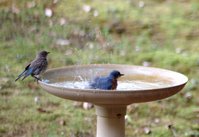
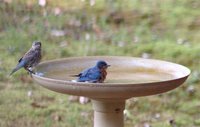
Late yesterday afternoon, in near 100-degree heat, a Bluebird family visited one of our birdbaths. I first saw two juveniles sitting together on the rim, as I happened to pass a window, and stopped to watch. One of the two sipped a drink. The other, after a moment, jumped in all the way and splashed around vigorously. A few minutes later, I looked again, and both parents were in the water, splashing around, with one juvenile sitting on the rim.
When Clate got these pictures, I couldn’t help thinking the male parent was trying to show the reluctant youngster how it’s done – but it’s more likely they were all hopping in and out, and we just happened to see them at these times. Anyway, I’m sure it felt good in this relentless, steamy heat.
Tuesday, August 07, 2007
Oases in a Heat Wave
This morning as I ate breakfast, I noticed three Titmice, a Chickadee and a Cardinal all competing for space on the hummingbird feeder hanging outside the window on the edge of the deck. I was puzzled at first, but then saw the Chickadee lean down from the chain and drink from the small moat of water in the middle of the feeder, meant to discourage ants. So they had come for water, not nectar.
Meanwhile, a male Ruby-throated Hummingbird hovered and hummed aggressively in the midst of the larger birds, darting at one and then another, his red throat flashing in the sunlight. The Chickadee jumped back from him a little, but stayed to drink another sip or two. I couldn’t tell if the Hummingbird chased them away in the end, or if they all just left when they wanted to, but once they were gone he hovered all around the feeder indignantly for several seconds.
I’ve been especially careful to keep two bird baths filled with fresh water in the shade in the front yard the past few days, with temperatures in the upper 90s. This morning I filled two shallow saucers with water and also put some water in a large shallow plant saucer, added a couple of rocks for perches, and set them all on the deck rail in back, in the shade of the oaks, just below a large hanging fern.
Earlier, when I left the house around 7:30 to walk through the neighborhood – at least 45 minutes later than would have been ideal – the sun blazed and shimmered like pink-gold foil, climbing into a cloudless blue sky and bleaching it white as it rose. Cicadas already sang loudly, and I heard few birds along the way – the whreeps of two Great-crested Flycatchers, the soft burble of Bluebirds here and there, the twitter of Chimney Swifts, one Blue Grosbeak still singing, a few Towhees calling To-wheee, and a Catbird complaining in the thickets of the Old Field. Otherwise, things were pretty quiet.
The day’s expected to be very hot, with temperatures around 100, humid, and pollution in the air at unhealthy levels. The heat and humidity aren’t unusual for us at this time of year. The air pollution, sadly, isn’t unusual anymore either. While I can escape it by staying inside, at least after about 10 am, and being thankful for air conditioning, the birds, butterflies, lizards, trees, and other wildlife can’t, and I have no doubt the pollution can’t be good for them.
Monday, August 06, 2007
Royal Walnut Moth
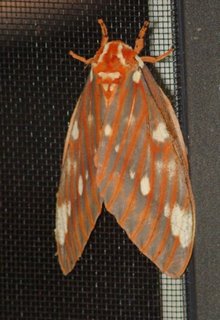
Early yesterday evening, Clate found and photographed a Regal Moth – also called a Royal Walnut Moth – on a window screen in the shade of our white oak trees. It was large and impressive, with rich orange coloring, especially on the head and the veins in the wings, and blurry spots of cream-yellow. From field guides, I learned that Citheronia regalis is fairly common, and – with a wingspan of five to six inches – is the largest kind of Royal Moth, and in the same family with Giant Silkworm Moths like Luna and Cecropia.
The caterpillars of Regal Moths feed on the leaves of several different species of forest trees, including hickory, black walnut, pecan, sweet gum and others. Called Hickory Horned Devils, the huge, brightly colored caterpillars look intimidating, with black spines on a blue-green body, and an array of black-tipped orange “horns” near the head, but they are said to be harmless. The adults do not eat, and live only long enough to mate and lay eggs.
Wednesday, August 01, 2007
Tiger Swallowtails, Silver-spotted Skippers and a Monarch
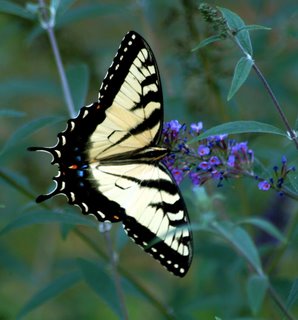
It’s getting to the time of year when I often watch butterflies and other insects almost as much as birds, since most birds are so quiet. Tiger Swallowtails, like this one Clate captured in a photograph, are the most noticeable butterflies around our yard right now. There’s almost always at least one or two floating through the trees or feeding on the blooms of a butterfly bush.
I enjoy the butterflies purely because they’re beautiful, of course – and often the greatest pleasure is in discovering the delicate colors and patterns of some that appear very plain at first glance. Learning to know them and recognize them is fun, and very similar to the joys of birding. And the colorful, sometimes fanciful and evocative names of butterflies alone might be enough to tempt me into watching them.
Red-spotted Purples are common around our yard – black butterflies with iridescent blue along the back edges of their wings and prominent red-orange spots on the undersides of their wings. Cloudless Sulphurs and Sleepy Orange butterflies flutter along the roadsides and over the Old Field on the edge of our neighborhood. And I might also expect to find Black Swallowtails, Buckeyes, Gulf Fritillaries, Viceroys, maybe an American Painted lady, and smaller, more subtly colored ones like Eastern Tailed Blues, Gray Hairstreaks and Common Wood Satyrs – all of which I’ve seen here in previous summers, but this year, especially lately, I’ve been preoccupied and haven’t been watching for them yet. I’m sure I’ve missed a lot.
Late this afternoon – a hot, humid, sunny day with a bleached blue sky and big white cumulous clouds – I went out to see what I could find. In the yellow-blooming lantana around the mailbox were several Silver-spotted Skippers, Fiery Skippers and at least two Common Sooty-wings. But the surprise of the day was to find a bright orange Monarch Butterfly feeding in the purple blooms of a butterfly bush along with a Tiger Swallowtail, several small bumblebees and a honeybee.
